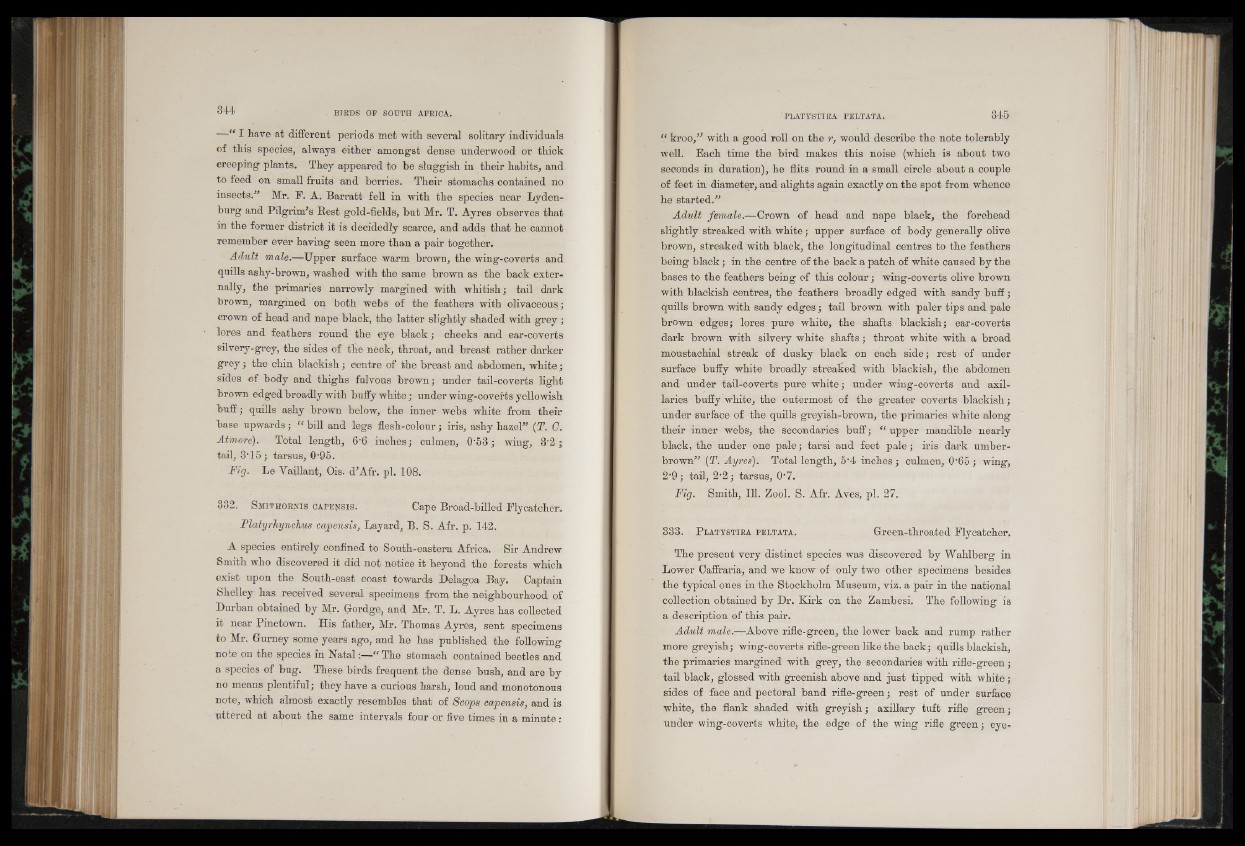
•—" I have at different periods met with several solitary individuals
of this species, always either amongst dense underwood or thick
creeping plants. They appeared to be sluggish in their habits, and
to feed on small fruits and berries. Their stomachs contained no
insects.” Mr. F. A. Barratt fell in with the species near Lyden-
burg and Pilgrim's Rest gold-fields, but Mr. T. Ayres observes that
in the former district it is decidedly scarce, and adds that he cannot
remember ever having seen more than a pair together.
Adult male.—Upper surface warm brown, the wing-coverts and
quills ashy-brown, washed with the same brown as the back exter-
nally, the primaries narrowly margined with whitish; tail dark
brown, margined on both webs of the feathers with olivaceous;
crown of head and nape black, the latter slightly shaded with grey;
lores and feathers round the eye black; cheeks and ear-coverts
silvery-grey, the sides of the neck, throat, and breast rather darker
grey ; the chin blackish; centre of the breast and abdomen, white ;
sides of body and thighs fulvous brown; under tail-coverts light
brown edged broadly with buffy white; under wing-covefts yellowish
buff; quills ashy brown below, the inner webs white from their
base upwards; “ bill and legs flesh-colour; iris, ashy hazel” (T. 0.
Atmore). Total length, 6'6 inches; culmen, 0'53; wing, 8'2 ;
tail, 3*15; tarsus, 0'95.
Fig. Le Yaillant, Ois. d'Afr. pi. 108.
332. S m ith o r n is c a p e n s is . Cape Broad-billed Flycatcher.
Platyrhynchus capensis, Layard, B. S. Afr. p. 142.
A species entirely confined to South-eastern Africa. Sir Andrew
Smith who discovered it did not notice it beyond the forests which
exist upon the South-east coast towards Delagoa Bay. Captain
Shelley has received several specimens from the neighbourhood of
Durban obtained by Mr. Gordge, and Mr, T. L. Ayres has collected
it near Pinetown. His father, Mr. Thomas Ayres, sent specimens
to Mr, Gurney some years ago, and he has published the following
note on the species in Hatal;—“ The stomach contained beetles and
a species of bug. These birds frequent the dense bush, and are by
no means plentiful; they have a curious harsh, loud and monotonous
note, which almost exactly resembles that of Scops capeusis3 and is
uttered at about the same intervals four or five times in a minute:
“ kroo,” with a good roll on the r, would describe the note tolerably
well. Each time the bird makes this noise (which is about two
seconds in duration), he flits round in a small circle about a couple
of feet in diameter, and alights again exactly on the spot from whence
he started.”
Adult female.—Crown of head and nape black, the forehead
slightly streaked with white; upper surface of body generally olive
brown, streaked with black, the longitudinal centres to the feathers
being black; in the centre of the back a patch of white caused by the
bases to the feathers being of this colour; wing-coverts olive brown
with blackish centres, the feathers broadly edged with sandy buff;
quills brown with sandy edges; tail brown with paler tips and pale
brown edges; lores pure white, the shafts blackish; ear-coverts
dark brown with silvery white shafts; throat white with a broad
moustachial streak of dusky black on each side; rest of under
surface buffy white broadly streaked with blackish, the abdomen
and under tail-coverts pure white; under wing-coverts and axil-
laries buffy white, the outermost of the greater coverts blackish;
under surface of the quills greyish-brown, the primaries white along
their inner webs, the secondaries buff; “ upper mandible nearly
black, the under one pale; tarsi and feet pale; iris dark umber-
brown” (I7. Ayres). Total length, 5'4 inches; culmen, 0'65 ; wing,
2'9; tail, 2'2; tarsus, O'7.
Fig. Smith, 111. Zool. S. Afr. Aves, pi. 27.
333. P l a t t s t ir a p e l t a t a . Green-throated Flycatcher.
The present very distinct species was discovered by Wahlberg in
Lower Oaffraria, and we know of only two other specimens besides
the typical ones in the Stockholm Museum, viz. a pair in the national
collection obtained by Dr. Kirk on the Zambesi. The following is
a description of this pair.
Adult male.—Above rifle-green, the lower back and rump rather
more greyish; wing-coverts rifle-green like the back; quills blackish,
the primaries margined with grey, the secondaries with rifle-green;
tail black, glossed with greenish above and just tipped with white;
sides of face and pectoral band rifle-green; rest of under surface
white, the flank shaded with greyish; axillary tuft rifle green;
under wing-coverts white, the edge of the wing rifle green; eye